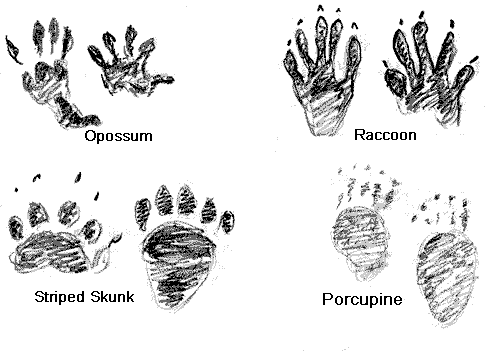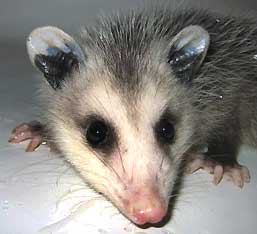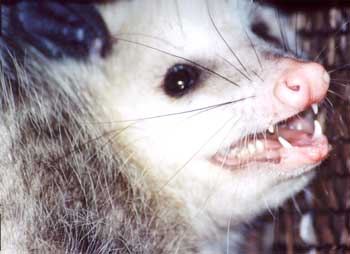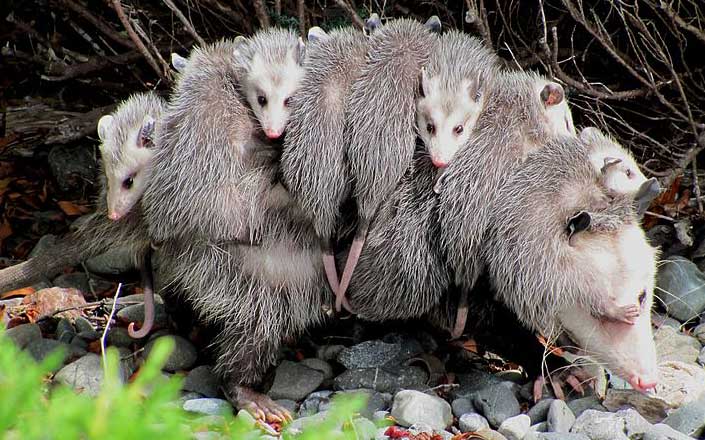 Opossum tracks compared with those of other common mammals
Opossum tracks compared with those of other common mammalsIf you live anyplace in the U.S. other than the far north or the western states' mountain or plateau region, and if you're in a small town or even a big one with some scattered natural or semi-natural parks or reserves, there's a fair chance that eventually a gray, cat-sized, long-haired, long-snouted, long-tailed animal will lumber across your backyard, or poke its pink nose at you over the edge of a garbage can. At first you may think you're seeing a super-huge rat, but it's none other than the opossum, sometimes known as the Virginia Opossum, Didelphis virginiana.
OPOSSUMS ARE MARSUPIALS
 Photo courtesy of Orlando Animal Rescue
Photo courtesy of Orlando Animal RescueIn many field guides to North American mammals, the opossum will probably be the very first of the 380 or so mammal species described. That's because opossums are North America's only marsupial, and marsupials are considered very ancient forms of mammals. Field guides often place the "primitive" organisms first. The vast majority of the world's marsupials occur mainly in Australia, where kangaroos are the best known of the group.
You know that kangaroo mothers carry their young in pouches on their bellies. So do opossums. Opossum babies are born after only eleven to thirteen days of gestation, gestation being the time lapsing between when the sperm unites with the egg, and the creature is born. At birth, newborn opossums are so tiny that an entire litter, consisting of up to 14 babies, can fit into a single teaspoon. They are so undeveloped that it's impossible for them to survive outside the mother.
However, their front legs are developed all out of proportion to the rest of their bodies, and are strong enough for the completely blind babies to pull themselves from their birth opening, across the mother's belly, into her pouch, or marsupium. They do this by instinct. If the mother is disturbed and moves during the babies' pouch-searching process, the babies may well lose their way, fall off, and perish. Once inside the pouch, the babies find a nipple, attach themselves to it very securely, and during the next two months ride in the mother's pouch continuing their development.
This pouch is quite an adaptation. It permits the mother to produce up to 14 or even 20 babies, who do much of their developing in the expanding pouch, instead of inside her body. As the young mature, they start spending more or more time outside the pouch, often riding on the mother's back. It's a kind of slow-motion birth making it much easier for the mother to have a big family.
OPOSSUMS HAVE TALENTED TAILS
The opossum's tail is long, thick, hairless, and very talented. It can wrap around things and hold onto them. Such useful tails are said to be prehensile. One of the most remarkable sights ever to hope for in our backyards is that of a mother opossum with all her babies riding on the mother's back, with their tails grasping hers, to keep from falling off.
OPOSSUMS "PLAY POSSUM"
Sometimes when opossums are cornered in a dangerous situation, they simply keel over into a dead faint. Many predators, such as dogs, then don't know what to do with a dead opossum. If the predator decides to leave, in a few minutes the opossum will raise its head and look around, and if no danger seems to be threatening, it'll rush to cover. It's been "playing possum." Research indicates that the opossum isn't really "playing" when it does this. It actually seems to undergo a kind of nervous collapse. Since opossums aren't well equipped for fighting, their "delicate nervous system" may be an adaptation for surviving attack by predators such as dogs, who may be more interested in a good fight than in eating a sick-acting opossum.
OPOSSUMS AREN'T FINICKY EATERS

One reason opossums are so successful is that they aren't fussy about what they eat -- they're real omnivores, eating nuts, flesh, eggs, insects, carrion, and just about anything that can be chewed and swallowed in the garbage can.

